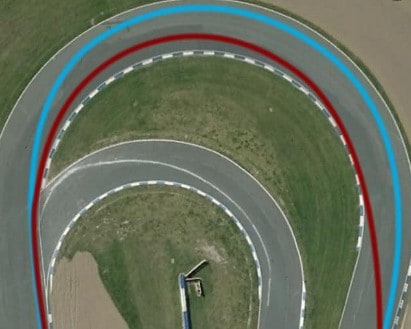If you’re not sure what it is, this article is a great place to start. Here you will discover about what it is and how to improve it.
While a racing line is one of the most important and visible features on a race track, few people are aware of its role and significance. In motorsport, the racing line denotes the most efficient route around the track. This path, in the majority of circumstances, uses the entire width of the track and lengthens the radius of a turn. It enters the turn from the outside edge, touches the apex, which is a point on the inside, and departs the turn from the outside edge.
Racers normally opt to stay on the racing line since it is the most efficient way to complete the race in the shortest amount of time. Because it is the best path around the racing circuit, tyre skid marks from prior cars can plainly be seen on the asphalt.
Race Line Optimization
Any race car driver’s first goal is to locate the best line around the race circuit. This will guarantee that they finish a lap around the circuit in the shortest amount of time feasible while making no mistakes. This line, however, may differ depending on whether the driver wants to complete the lap in the quickest time feasible, save gasoline and tyres, or overtake another driver in the race. Chicanes, conventional corners, straights, and double apexes are all frequent ways to divide a racing circuit into distinct components. Furthermore, these typical corners may be split down into a deceleration phase when approaching the corner, followed by the apex, and finally acceleration as the turn is exited.

Corner Entry
The initial phase of a turn starts with a straight-line threshold braking. The driver’s main goal is to get the maximum deceleration rate possible. The turn-in phase follows, in which the driver begins directing the car towards the apex. Most drivers are trained to complete braking before this point and perform a more circular turn towards the apex while maintaining a steady speed.
However, in recent years, numerous drivers have begun to incorporate trail braking into curve entrance. Trail braking occurs when the brake pressure is maintained above the turn-in point, allowing the vehicle to descend more quickly due to the forces exerted by the tyres. It also aids the automobile in turning in a more efficient manner. This also leads the automobile to follow an Euler spiral route, reducing the radius to the apex. It will result in a faster average speed and less elapsed time than a traditional circular entrance if done correctly.
Apex
In basic words, the apex, also known as the clipping point, is the point on the inside of the corner when a vehicle passes the closest. It is the point in the corner when the vehicle has the slowest speed and the smallest radius, to make it easier to grasp.
It may also be divided into two types: an early apex and a later apex. While an earlier apex will reach the corner’s interior, a later apex will have a broader radius. Furthermore, the earlier apex has a faster speed. A driver’s apex is mostly determined by the car’s cornering ability.
Corner Exit

This phase begins as the automobile accelerates after passing through the apex. It is frequently referred to as the most crucial feature of any turn that contributes to a faster lap time. As a result, a driver’s departure performance must be optimised. The major goal in this phase is to maximise acceleration while keeping the vehicle pointed in the appropriate direction for the straight ahead.
Any vehicle with a lesser acceleration potential will do this primarily by applying full power from the apex and taking a more circular course. Vehicles with a larger acceleration potential, on the other hand, may have wheelspin and be unable to reach full speed until the bend is completed. This may result in a corner escape path.

